Amelia Groom on Emma Wolf-Haugh’s Eileen Gray and the queer arts of reappropriation.
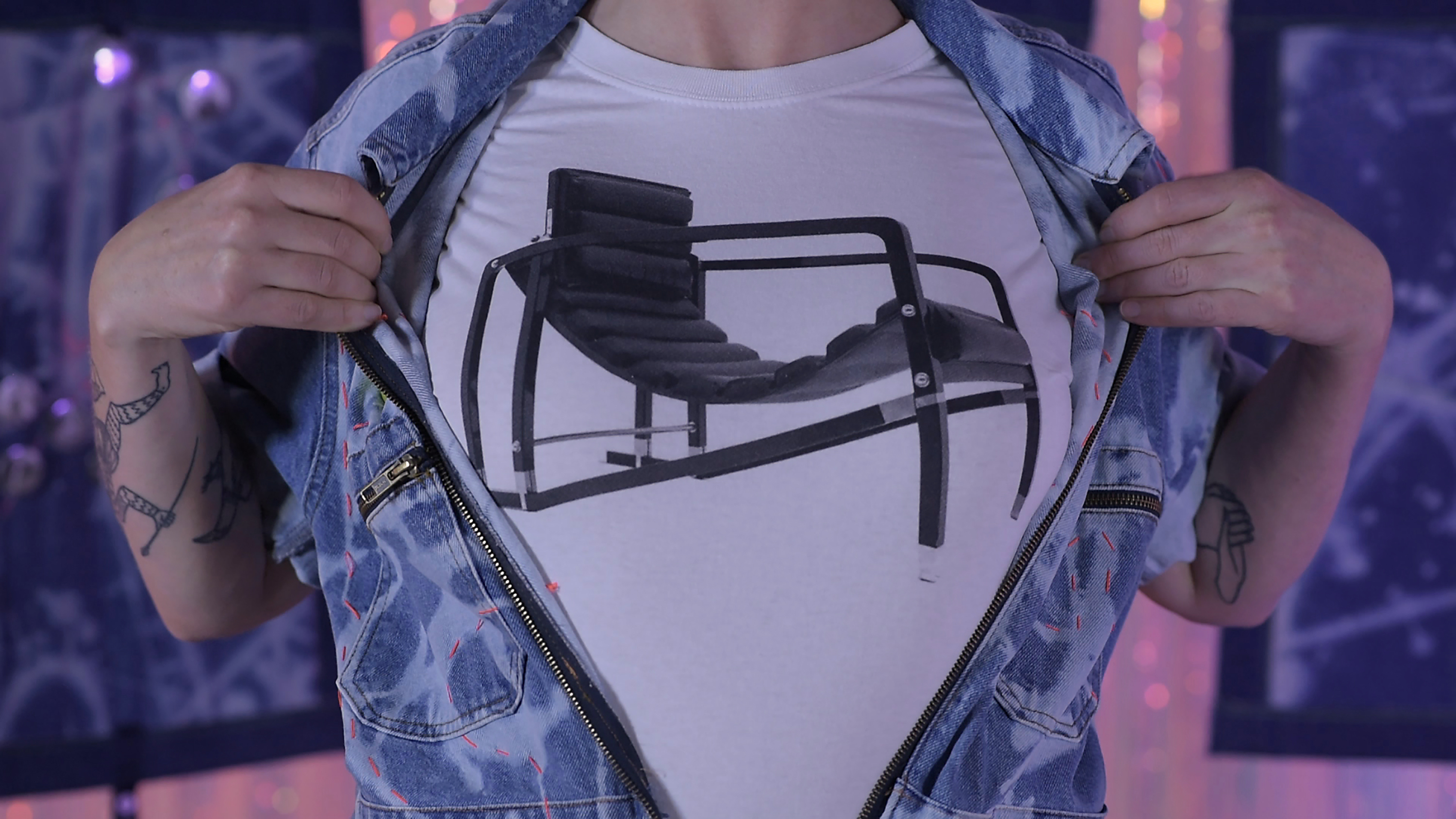
Emma Wolf-Haugh, Domestic Optimism, Act One: Modernism—A Lesbian Love Story, 2020. Video still. Single-channel video, 36 min. Courtesy of the artist.
What I remember most about Emma Wolf-Haugh’s performance Poverty of Vision—my first encounter with the artist’s practice, back in 2017—is the lip-syncing. The work premiered at the Irish Museum of Modern Art as part of a series of commissions where artists were invited to respond to the archives of Rosc, an international exhibition that was held in Ireland six times between 1967 and 1988. Focusing on the 1984 iteration of Rosc, Wolf-Haugh’s performance also drew from their memories of growing up as a queer kid in Dublin in the eighties.
As they recounted, 1984 was the year they saw the film Footloose, which became for them an early source of queer identification via enthusiastic projection. “Kevin Bacon plays me as I want to become: lean and cool with the body of a dyke and the charm of a queer boy . . . My ten-year-old body occupies his acrobatic lesbian force, hoping for a flat chest, no tits, like Kevin Bacon please,” Wolf-Haugh said. “This is what popular culture in the eighties has on offer, and I take it and make it my own. In not seeing myself reflected back, I make myself up.” Towards the end of Poverty of Vision, the artist—who has a background in community theater, DIY club scenes, and drag king performance—delivered a joyously campy lip-sync rendition of Deneice Williams’s “Let’s Hear It for the Boy,” the hit single from the Footloose soundtrack. “Let’s hear it for the boy!” they sang, without producing any song. “Let’s give the boy a ha-a-a-a-a-nd . . .”
What happens when queer lips sync with the cultural products that have excluded them? The voice arrives from somewhere beyond the body of the singer; they’re ventriloquized by a language that comes before them and operates externally to them. But the lip-syncing performer also presses back into the existing language, by displacing and thereby reshaping its possibilities. While pop songs course through bodies everywhere, the silently singing drag artist carries out a re-embodiment, wherein even the most seemingly cis-heteronormative lyrics can suddenly take on entirely new resonance. The magic is that this can happen simply through reframing and reclaiming—without any original vocal expression and without even changing the words that already exist.
Over the last decade or so, Wolf-Haugh’s work has often returned to queer practices of reappropriation. Their current research project, Domestic Optimism, marks the third and final phase of THRXSOME, a trilogy of works concerned with the politics of space and sexuality. The first of these, The Re-appropriation of Sensuality (2015), looks at the spaces of sex clubs from the perspectives of dykes, queer women, and trans folk. The second, Sex in Public (2018), reappropriates descriptions of cruising sites and sexual encounters in public space from literature written by gay men. The ongoing final phase—which started before the pandemic confined so many aspects of life to domestic spheres—turns to homes, housing, and the possibilities of what Wolf-Haugh terms “sexually dissonant domestic design.”1
A starting point in the artist’s research for Domestic Optimism was the Irish-born queer Modernist designer and architect Eileen Gray. Gray followed many of the principles of the Modern movement, but she was critical of what she saw as its excessive rationality and “atrophy of sensuality.”2 She also rejected the movement’s obsession with purity and hygiene—“Hygiene to bore you to death!” she once remarked.3 She moved in the Sapphic circles of Paris’s Left Bank during the interwar years, and her work was long overlooked in the histories of Modern architecture and design.
Gray’s most legendary work is her French Riviera villa e.1027, which she completed in 1929 for herself and her then-lover, Jean Badovici. When people write about e.1027, they tend to write about the many misfortunes the building has suffered. How its walls were used for shooting practice by occupying Nazis during the war. How it had, until recent restoration efforts, sat for years as an abandoned ruin. How it was routinely misattributed to various men in architecture history books.4 Most of all, how Le Corbusier was weirdly, invasively obsessed with it. (After a failed attempt to buy it, he acquired the adjacent land and built a hut overlooking Gray’s estate; in her absence, and against her wishes, he painted erotic murals across her white walls. He later drowned while swimming in the sea below the property.) Now salvaged from historical oblivion and securely positioned as part of the canon—where it stands as a rare example of a Modernist building designed by a woman—e.1027 is still too seldom discussed on its own terms.
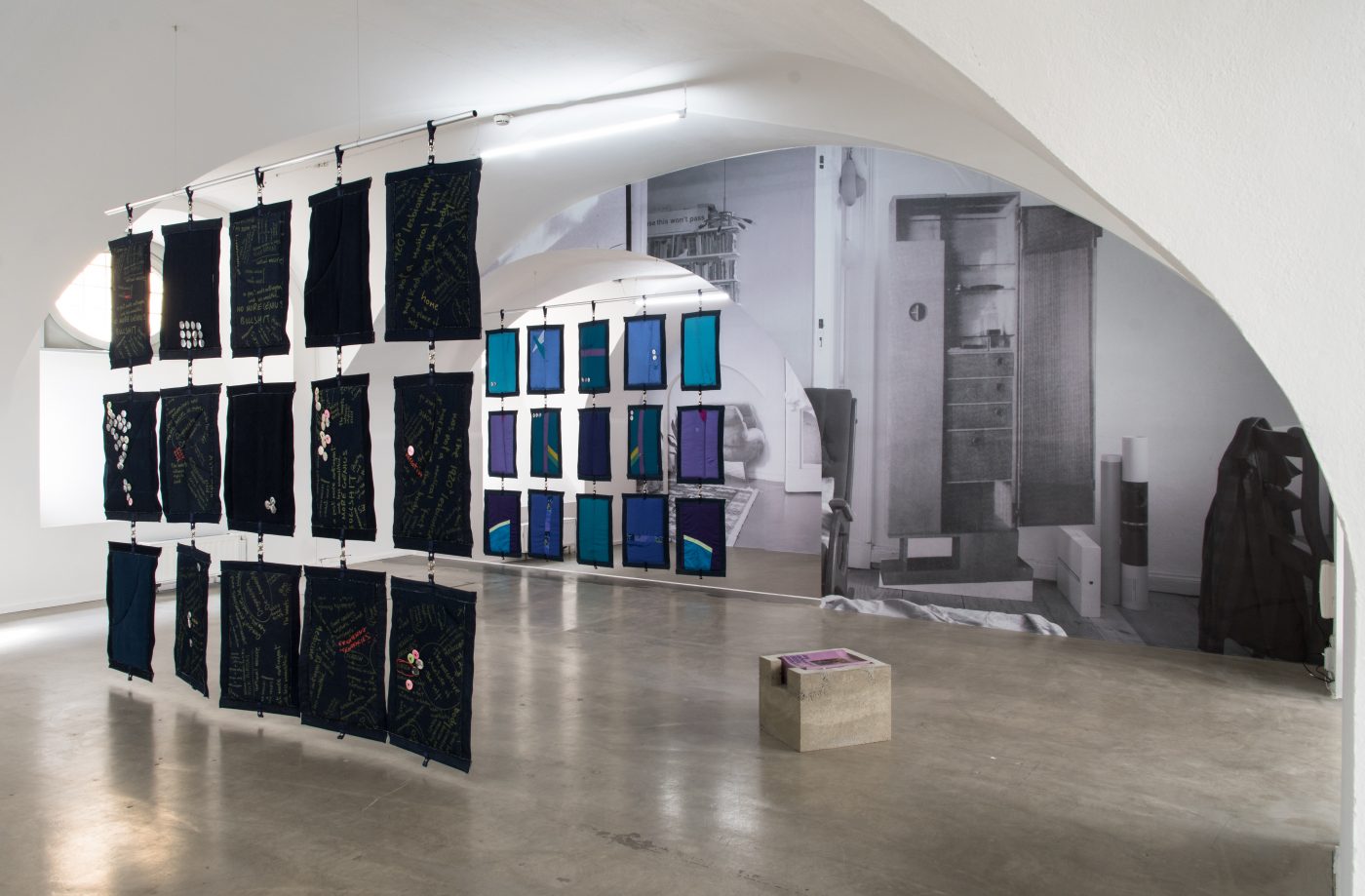
Emma Wolf-Haugh, Domestic Optimism, Act One: Modernism—A Lesbian Love Story, installation view, September 24–November 20, 2020, Grazer Kunstverein, Graz, Austria. Photo: Christine Winkler.
One aspect of Gray’s approach that Wolf-Haugh’s project picks up is her troubling of the separation between architectural structure and ornament—a separation that is often gendered, with structure standing for the most primary element, and ornament being feminized as a trivial, secondary appendage. In e.1027, the structural, functional, and ornamental are all interwoven. Feminist architect and researcher Katarina Bonnevier describes how “screens transformed into walls and rugs combined with floors,” as if Gray had “folded the surfaces into spaces.”5 Gray herself proclaimed that “Architecture must be its own decoration,” and “the furnishings should lose their individuality by blending in with the architectural ensemble.”6
In September 2020, Wolf-Haugh’s Domestic Optimism Act One: Modernism—A Lesbian Love Story opened at the Grazer Kunstverein, in Graz, Austria, as the first of two solo exhibitions marking the culmination of the Domestic Optimism research project.7 The gallery’s main room was partitioned by a series of hanging screens, called Soft Modulars (2019–20), which were patchworked from scraps of denim garments and tracksuits, with dimensions that were based on Gray’s free-standing, lacquered-wood screens from the 1920s.8 Across the Soft Modulars, Wolf-Haugh presented various research materials and ephemera: badges, hand-stitched slogans, and various DIY retellings. Here and throughout the show, images were cheaply reproduced, cut out, cut up, and reworked through collaging techniques, in keeping with the artist’s long-standing zine practice.9 There were also actual zines, stacked in custom-built cast-concrete plinths, including an abominable little perversion (2020), which compiles the results of a collaborative writing workshop that Wolf-Haugh held online during the 2020 lockdowns, in which participants were invited to write queer-feminist erotic fan fiction to pieces of Gray’s furniture.
Domestic Optimism Act One also included a number of Gray’s chairs and other furniture items, which were reproduced cheaply as lightweight, two-dimensional cutouts. Printed to scale in black-and-white and mounted on crooked angles, these defunctionalized furnishings marked a playful attempt to move what have become extremely precious collectibles and museum pieces into a newly accessible ornamentality. One of these bootleg trompe-l’oeil reproductions appears in Wolf-Haugh’s photograph Bibendum Chair in the Modern Lesbian Home (2019)—which became part of a series of photographic murals that lined the walls of the Kunstverein and occupied several billboards around the city of Graz.
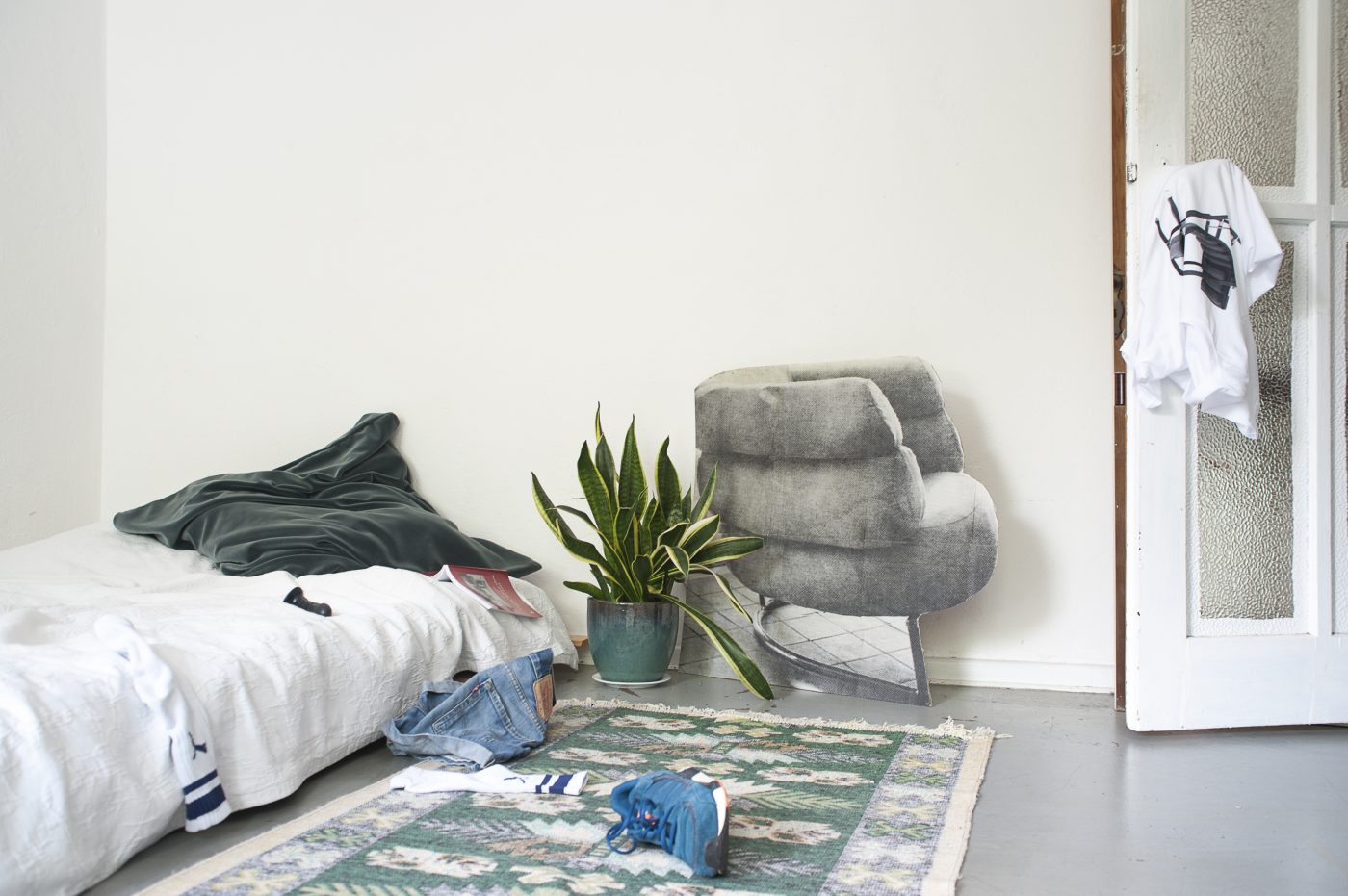
Emma Wolf-Haugh, Bibendum Chair in the Modern Lesbian Home, 2019. Color photograph, dimensions variable. Courtesy of the artist.
Bibendum Chair in the Modern Lesbian Home shows the interior of the artist’s Berlin apartment. There’s a rug, a pot plant, some items of clothing strewn around, a bed on the floor, and a dildo lying on it, next to a book that has been left open (close inspection reveals it to be Jasmine Rault’s Eileen Gray and the Design of Sapphic Modernity). Casually leaning against the wall is a to-scale cut-out image of the 1926 Bibendum Chair, one of Gray’s most iconic designs.10 The title of the photograph plays on the dual sense of the word modern—moving us between the present tense of the modern day and the historical period of Modernity, to affirm that the historical narrative is not something fixed and closed off, that it is necessarily reworked in the present, through ongoing practices of reclaiming and reframing.
The motif of fire appeared several times throughout the exhibition, beginning at the entrance to the Kunstverein, where reproductions of furniture items were ablaze with stylized depictions of curling orange flames. As a destructive force, fire is part of the iconoclastic impulse that flares up throughout this project in response to an excessively static and rarefied historical narrative. But fire is also warmth, light, and transformation. The furniture is burning down; it might also be rising up, phoenix-like, out of the blaze—a blaze that offers a queer illumination of other historical possibilities (some of which, as we will see, end up getting pretty heated).
According to the artist, the presence of fire also relates directly to their interest in reappropriation practices. Like the word queer, the word flaming was once part of the derogatory vocabulary of homophobia; to be flaming was to be obviously—flamboyantly—gay, in a world of persecutory hetero conformity. The historical reclamation of the word faggot was also part of Wolf-Haugh’s research. Originally referring to a bundle of twigs used for kindling on a fire, some believe that the term carries association with the burning of gay men at the stake during the European witch hunts.11 “To think that the word faggot gets reclaimed by queers is astounding to me,” Wolf-Haugh remarks. “I’m really into that, how people . . . can be placed in the most abject social positions and still manage to make space for themselves.”
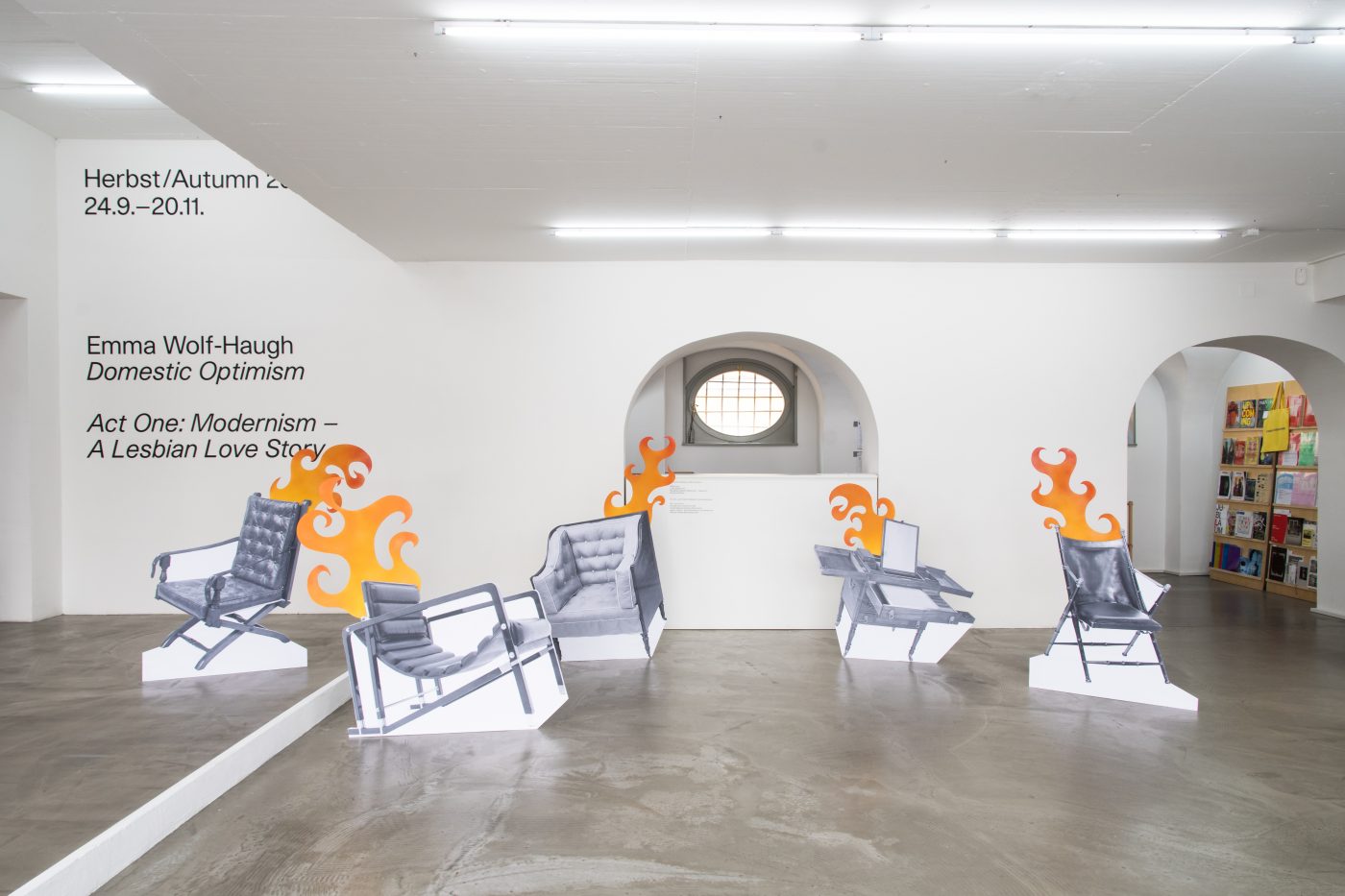
Emma Wolf-Haugh, Set Pieces, 2020. Printed black and white photographs pasted to wooden board, spray painted flames, dimensions variable. Installation view, Domestic Optimism, Act One: Modernism—A Lesbian Love Story, September 24–November 20, 2020, Grazer Kunstverein, Graz, Austria. Photo: Christine Winkler.
In reclaiming aspects of Gray’s legacy, the Domestic Optimism project also carries out an acerbically playful critique of the historiographic construction of geniuses. Once written out of Modernist architecture and design histories, Gray has now finally been plucked from obscurity. During Wolf-Haugh’s research, though, they were increasingly dissatisfied with the individualized canonization of Gray’s legacy. “As soon as she’s pulled into the canon, you start to see the same machine of history-making kick in,” they remark. “There’s such a laziness to it! The story becomes so heavily edited, because you have to have a singular figure, and that always overrides the complexity of the collective . . . For me, it’s really an ongoing feminist project to not be attached to individual genius, and to not replicate that mode of idolization.”
While Gray is now ensconced in the scholarship as a stand-in for all of the lost women of Modernist architecture and design history, Wolf-Haugh’s project insists on seeing her within the broader and messier picture of what they call “the lesbian scenius”—adopting Brian Eno’s portmanteau scenius, in which the myth of autonomous genius falls apart. Rather than simply slotting more excluded figures into the historical narrative while continuing to reproduce the existing structures of individualized excellence, Wolf-Haugh’s proposal is that bringing the excluded parts of the picture to light should help us to break apart that picture’s ideological foundations. It might feel to some like a loss, but losing grip on the heroic genius model is something that this project continually affirms in terms of abundance and proliferation: once we’ve given up on the gushy worship of isolated figures, complexity swells, and we can find ourselves able to deal in new ways with the nuanced entanglements of lives lived together, while acknowledging the messy erotics of shared knowledge production.
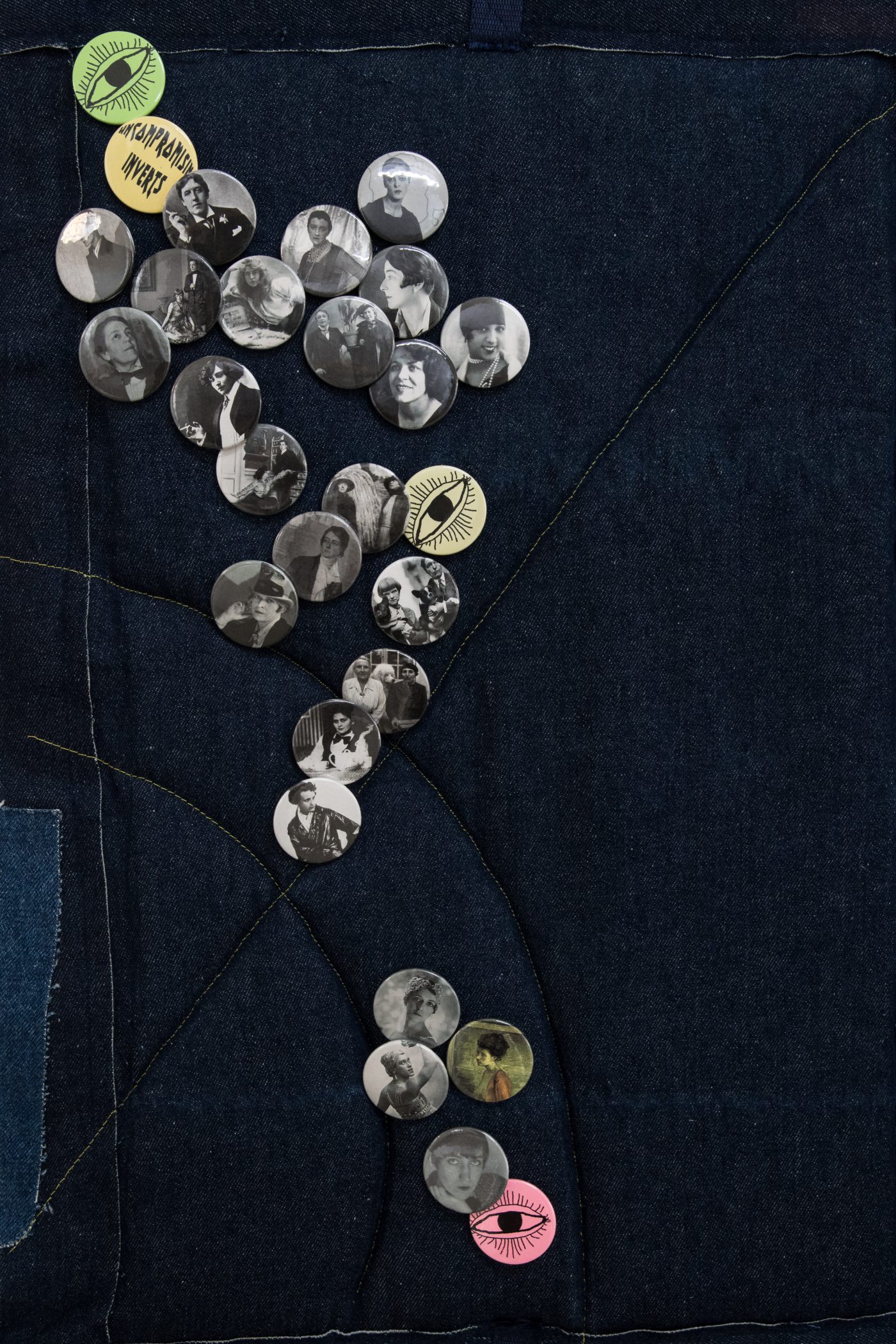
Emma Wolf-Haugh, Soft Modular, After Eileen Gray’s Block Screens #2 (detail), 2020. Recycled patchwork denim jackets, quilting, badges, found photographs, 21 in. x 16 in. Photo: Christine Winkler.
The exhibition in Graz culminated with Wolf-Haugh’s eponymous film, Domestic Optimism, Act One: Modernism—A Lesbian Love Story (2020), which was installed in the final room of the gallery. Throughout this film, the category of The Genius comes up against the category of The Lesbian—where “lesbian” is not so much a sexual orientation as it is a collective mode of creative and erotic entanglement, within which the genius logic falls short, and then falls apart. “To better understand the historical intricacies at play,” the voice-over states, “we begin with a little known but decisive turn in Modernist design: Le Corbusier’s unresolved, lifelong desire for lesbians.” This desire, we are told, was “undoubtedly borne of his enduring and fruitless longing to become lesbian . . . In the brothels of a lively interwar Paris, he paid sex workers to be erotic with each other, to be lesbian for him. He made drawings; huge thighs [and] big bums he liked the best—Corbusier coveted a LOT of lesbian.” On the screen, we see reproductions of some of Le Corbusier’s erotic lesbian sketches from the 1920s.
Despite his obsessive longing, the voice-over tells us, Corbu was also shrewd enough to understand that “if he became a lesbian, he could not become a genius.” Like all geniuses, he knew that he didn’t want to share: “To become lesbian, one must acknowledge that physically and creatively there is a continual rubbing off and up against one another,” and “this kind of corporeal and psychic merging, he was not willing to accept.” So Le Corbusier begins to build himself a tall and narrow pillar, continually writing his collaborators out so that he can be elevated in triumphant isolation. “UP, UP, UP went Corbu, narrow and cramped on his podium, no room for his inner large-limbed superabundant lesbian.”
While Corbu features in this historical fantasy as a man who wanted to be lesbian but chose instead to be genius, Gertrude Stein emerges toward the end of the film as “a lesbian who became a man in order to become a genius.”12 We are transported back in time to an imagined night in Paris, when a Sapphic salon is being held in honor of Stein’s genius. Eileen Gray is there, as part of an extended scene of women whose lives are entangled in various ways—romantically, intellectually, financially, domestically, erotically, creatively. As the different historical figures are introduced, they assemble on screen as hand-held paper cutouts made from Xeroxed archival images. Each one features a little bit of fire—painted depictions of bright orange flames pinned on so the burn is rising out of the old black-and-white pictures.
The film’s voice-over describes the scene of the salon. Displayed on the wall is Medallion (also known as the “YouWe” portrait, 1936), a “lesbian-merging portrait” by the painter Gluck, along with a painting of Gluck by Romaine Brooks, titled Peter (A Young English Girl) (1923–24). There’s also a portrait of the “aristocrat communist” Lily de Gramont, which was painted for her wife, the “Salon queen, heiress, poet, and lover of a great many women,” Natalie Barney. This painting is also by Brooks, who was also Barney’s lover. Barney is hosting the event, and dozens of other “interconnected friends, lovers, and feminist comrades” are gathered.
Stein, we are told, is sitting on a chair upholstered with tapestries, by her partner Alice Toklas, which were based on designs by their genius friend Pablo Picasso. As Toklas runs her fingers across the tapestry on the back of the chair, she starts to feel herself being pulled in by its threads . . . The tapestry is coming to life, undoing itself and gradually weaving the women in the room into an ecstatic entanglement. The animated upholstery soon pulls Gray into the web, together with the designer and choreographer Gaby Bloch. There’s no way out, and it turns out that it feels good. Bloch “uses her training to experiment with movement inside the entanglement, and finds that if one moves with the connection, and not against it, then motion is not only possible but also pleasurable.” With “the threads pulling, pressing, and vibrating in all the right places . . . the women give in to the bounded group body,” and “the room slowly fills with sighs, moans and shudders of gratification.”
The image on screen cuts from the gathering of Xeroxed portraits to shots of Wolf-Haugh in a denim jumpsuit, wrapping an orange thread around their fingers. In a series of close-ups, the camera also pans over orange stitches that run across and through the surface of the jumpsuit, as the voice-over continues to narrate the scene of the Paris salon. Stein has been pulled into the orgiastic throng, but she’s trying desperately to disentangle herself. “These binds are intolerable,” she implores, “one must know where one begins and ends!” Ada Smith then arrives late to the gathering, arm in arm with her lover Josephine Baker. Looking on with amusement, Smith tells the panicked Stein, “Gertrude, honey, you’re part of the scenius now . . . You might force yourself to an oblique angle, heaving your body to the front of the picture, but we’ll all still be here, moving in and out of the tapestry, spilling out of the frame . . . It’s the lesbian scenius, baby, and without it, there is no Modernism worth shit!”
The film ends with a lo-fi dance-music track that affirms the more-than-genius lesbian scenius. “It’s genius in communal form,” sings a computerized voice, while Wolf-Haugh dances and lip-syncs the lyrics. “More fun to be more than one!” We cut back to the group of women assembled at the imagined Paris salon—black-and-white cutouts that become a collaged chorus of historical figures singing across time, with an emphatic message: “Individuality combined; we were that way inclined; remember us together, tethered; pick us apart, lose the heart!” “See the scenius, not the genius.” “Yeah, oh yeah; don’t kill the buzz!”
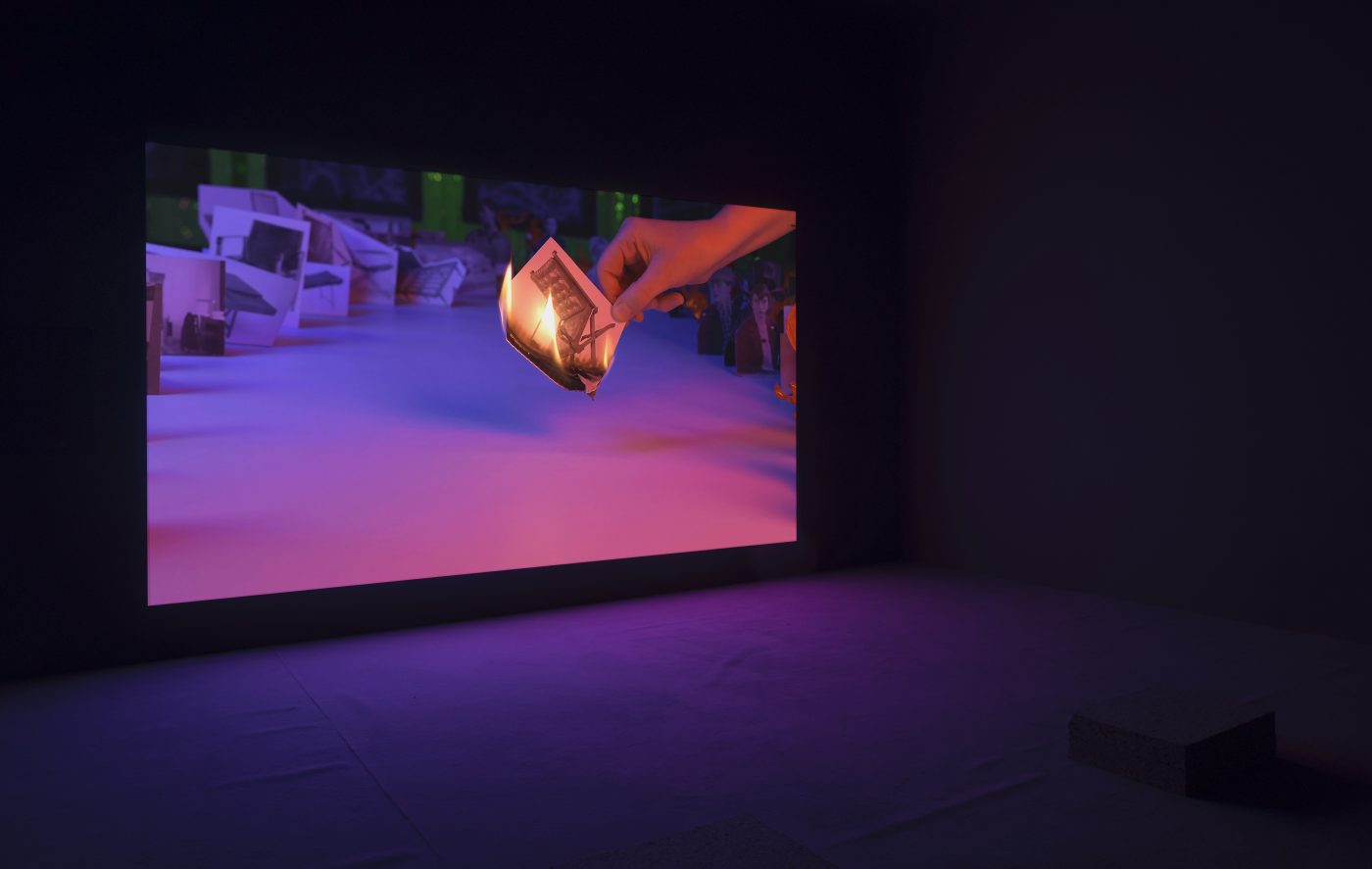
Emma Wolf-Haugh, Domestic Optimism, Act One: Modernism—A Lesbian Love Story, 2020. Video still. Single-channel video, 36 min. Courtesy of the artist.
In critiquing cultural attachments to the notion of genius, Wolf-Haugh’s project also insists on grappling with the limitations and problematics that we tend to avoid when we idolize individuals.13 One of the ways in which they complicate the purely celebratory reading of Gray’s legacy is by looking at the colonial aesthetics that seem to have influenced her designs. Gray grew up in an Anglo-Irish aristocratic household that contained a number of pieces of British campaign furniture, which could be disassembled or folded up for portability. Designed for ease of travel during imperialist military campaigns, these collapsible furnishings often served multiple purposes.
There’s a similar kind of multifunctionality at play in Gray’s designs, and it’s a feature of her work that has, in recent years, been read through a lens of queerness. In Bonnevier’s text “A Queer Analysis of Eileen Gray’s E.1027,” for instance, she writes about the adaptability of Gray’s spatial designs, and the ways in which the e.1027 building directly engages bodily participation: “Walls and screens can slide aside and windows flip into disappearance, the bar can be folded into the wall, tables can be linked, folded and extended, sideboards and drawers pivot—motion is everywhere.”14 Initially excited about these ideas of interactive fluidity and queer versatility in Gray’s designs, Wolf-Haugh was then “happily disturbed” by the realization that colonialist campaign furniture shared the same qualities. “It really challenged my thinking,” they recall. “Suddenly I had to face the fact that what we want to read through a register of sexual dissonance in Gray’s work is also uncomfortably bound up with the legacy of the British Empire.”
While researching Gray and the other Sapphic Modernists of the Parisian circles she moved in, Wolf-Haugh also became increasingly attuned to the degree of their wealth and class privileges. In the artist’s words, “These women were for the most part extremely affluent people, and that’s really why they can be remembered in this way at all—however belatedly.” For the next phase of the project, the artist is moving away from Gray and her milieu, in order to engage with working-class critiques of the legacy of Modernism. Scheduled to open at Project Arts Centre in Dublin in the Fall of 2021, the exhibition Domestic Optimism Act Two: Radclyffe Hall–The Lazerbeam Theirstory Projects will shift into a mode of speculative fantasy set at Ballymun, which was a high-rise social housing estate in the north of Dublin. Built in the 1960s—with plans that were optimistically based on Le Corbusier’s Radiant City—the Ballymun Flats are usually remembered as an instance of failed Modernist utopianism, and the towers were all demolished in the early twenty-first century. While carrying out research at the Ballymun Community Archives, though, Wolf-Haugh started to delve into the rich and largely overlooked history of community organizing and activism at Ballymun, and they are now writing a work of utopian fiction that imagines a surviving tower block squatted by working-class queers.
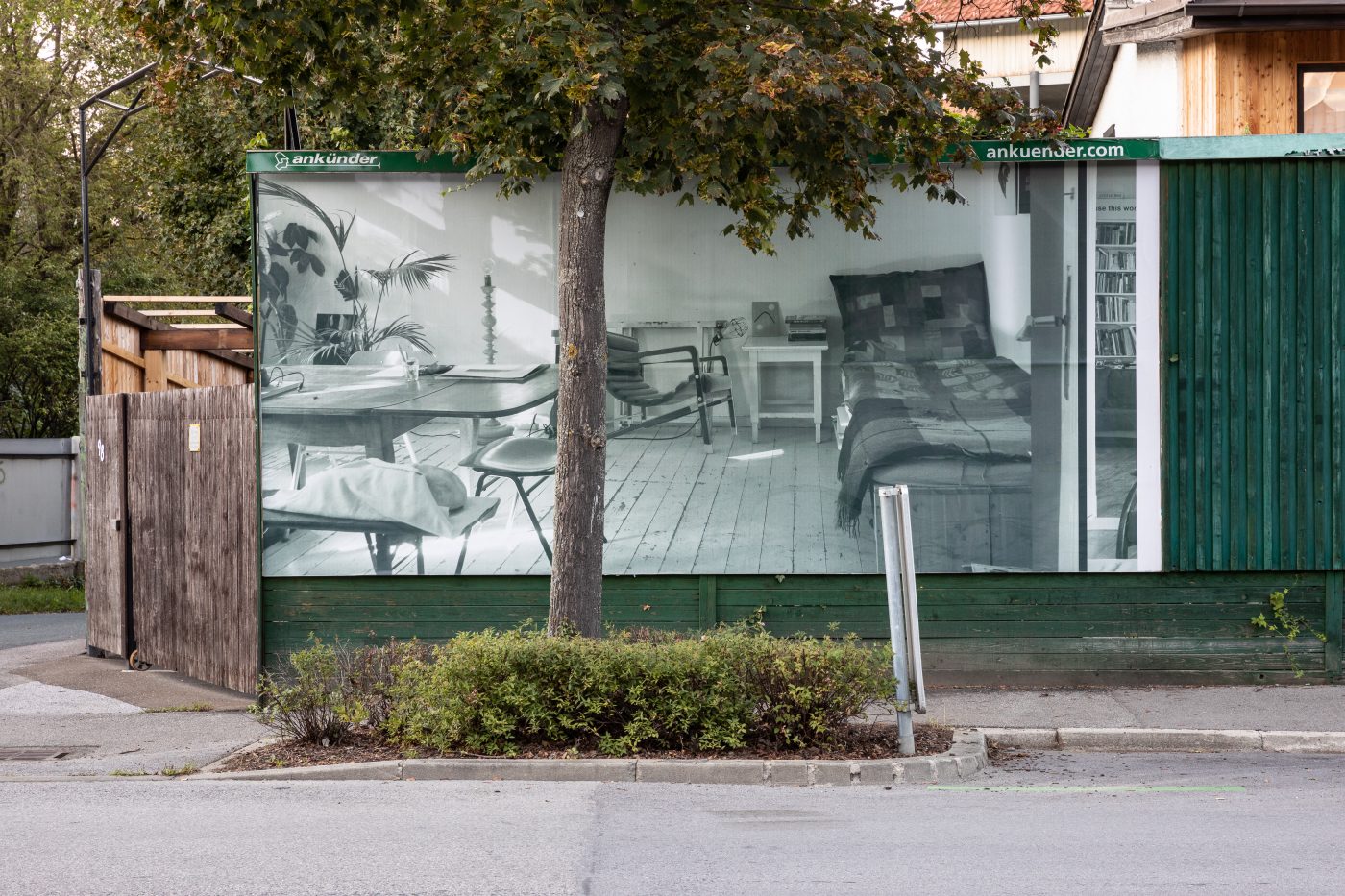
Emma Wolf-Haugh, Modernist furniture for dyke homes—Wallpaper #3—Transat Chair by Eileen Gray, Kreuzberg, 2020. In collaboration with Line Skywalker Karlström. Installation view, Wienerstraße 98a, Domestic Optimism, Act One: Modernism—A Lesbian Love Story, September 24–November 20, 2020, Grazer Kunstverein, Graz, Austria. Photo: Thomas Raggam.
Given the historical vilification of queers, it’s unsurprising that queer historians have tended to be loving and celebratory while doing the work of salvaging overlooked figures. Throughout this project, though, Wolf-Haugh insists that to only praise is to ultimately do a disservice to queer history, if it replicates the existing logics of individuation and bypasses real complexities and internal contradictions. Here, queering the narrative is not simply a cumulative project of inserting more queer lives into the scene in order to establish a fuller historical account. Rather, throughout Domestic Optimism, the whole historiographic approach is queer insofar as it continually unsettles, through retellings that are unapologetically shot through with open-ended speculation, fantasy, and play.
While the project presents an historiographic imperative to reappraise and acknowledge the untidy realities of collective entanglements, the promise contained within this critical provocation is that, as the women at the Paris salon in the film discover, “Motion is not only possible but also pleasurable.” Rather than frame the imperative in terms of extra work or burdensome distraction, Wolf-Haugh’s Domestic Optimism offers it as an invitation: here is a site of abundant possibility, pleasure, and proliferation. x

Amelia Groom is a Berlin-based writer and postdoctoral researcher at the Royal Danish Academy of Fine Arts in Copenhagen. Her book Beverly Buchanan: Marsh Ruins was published recently in the Afterall One Work series.